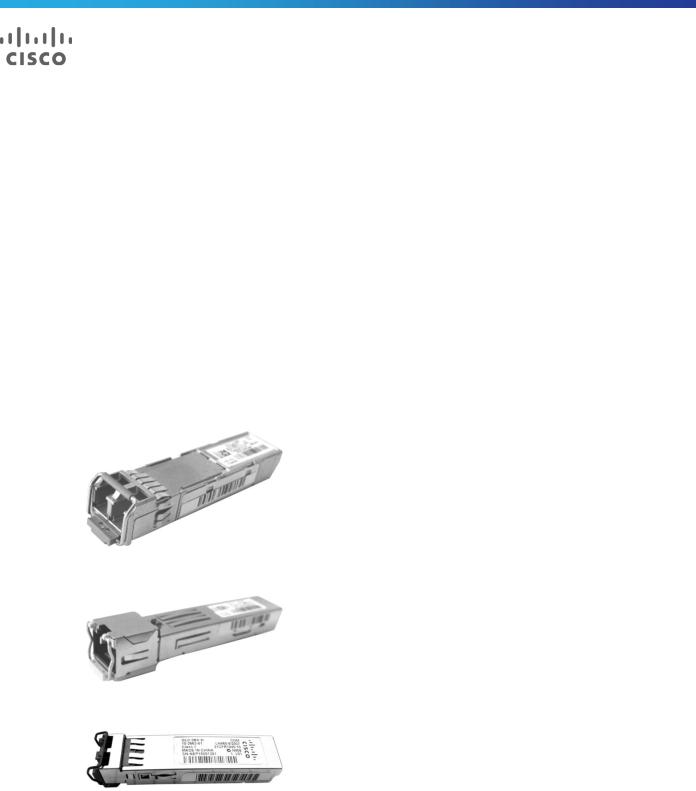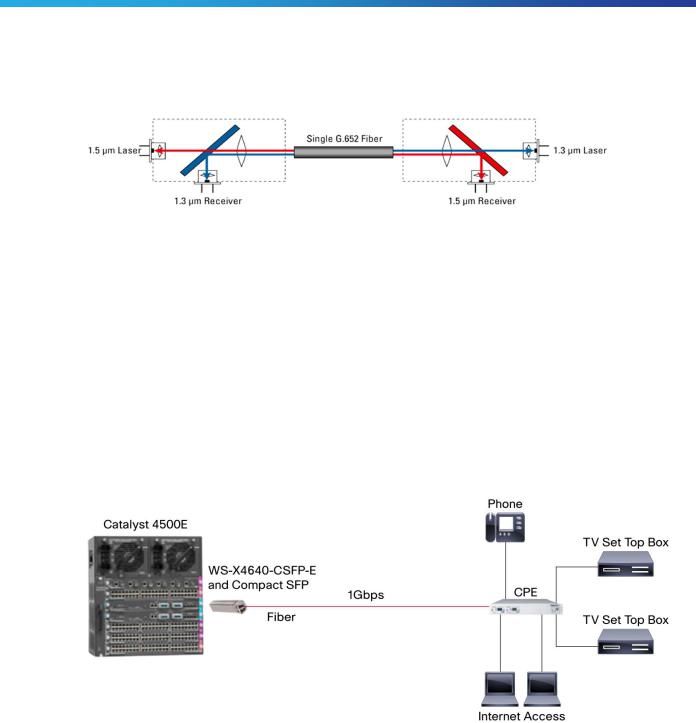Cisco 1000BASE-SX, 1000BASE-LX, 1000BASE-EX, 1000BASE-ZX, 1000BASE-BX-U User Manual
...
Data Sheet
Cisco SFP Modules for Gigabit Ethernet
Applications
Cost-effective Small Form-factor Pluggable (SFP) transceivers for Gigabit Ethernet applications
Product Overview
The industry-standard Cisco® Small Form-Factor Pluggable (SFP) Gigabit Interface Converter (Figure 1) links your switches and routers to the network. The hot-swappable input/output device plugs into a Gigabit Ethernet port or slot. Optical and copper models can be used on a wide variety of Cisco products and intermixed in combinations of 1000BASE-T, 1000BASE-SX, 1000BASE-LX/LH, 1000BASE-EX, 1000BASE-ZX, or 1000BASE-BX10-D/U on a port-by-port basis.
Figure 1. Cisco Optical Gigabit Ethernet SFP
Figure 2. Cisco 1000BASE-T Copper SFP
Figure 3. Cisco 2-Channel 1000BASE-BX Optical SFP
Features and Benefits
●Hot swappable to maximize uptime and simplify serviceability
●Flexibility of media and interface choice on a port-by-port basis, so you can “pay as you populate”
●Robust design for enhanced reliability
●Supports digital optical monitoring (DOM) capability
© 2016 Cisco and/or its affiliates. All rights reserved. This document is Cisco Public Information. |
Page 1 of 9 |

1000BASE-T SFP for Copper Networks
The 1000BASE-T SFP operates on standard Category 5 unshielded twisted-pair copper cabling of link lengths up to 100 m (328 ft). Cisco 1000BASE-T SFP modules support 10/100/1000 auto negotiation and Auto MDI/MDIX.
1000BASE-SX SFP for Multimode Fiber Only
The 1000BASE-SX SFP, compatible with the IEEE 802.3z 1000BASE-SX standard, operates on legacy 50 μm multimode fiber links up to 550 m and on 62.5 μm Fiber Distributed Data Interface (FDDI)-grade multimode fibers up to 220 m. It can support up to 1km over laser-optimized 50 μm multimode fiber cable.
1000BASE-LX/LH SFP for Both Multimode and Single-Mode Fibers
The 1000BASE-LX/LH SFP, compatible with the IEEE 802.3z 1000BASE-LX standard, operates on standard single-mode fiber-optic link spans of up to 10 km and up to 550 m on any multimode fibers. When used over legacy multimode fiber type, the transmitter should be coupled through a mode conditioning patch cable. For details on this implementation, refer to http://www.cisco.com/en/US/prod/collateral/modules/ps5455/product_bulletin_c25530836.html.
1000BASE-EX SFP for Long-Reach Single-Mode Fibers
The 1000BASE-EX SFP operates on standard single-mode fiber-optic link spans of up to 40 km in length. A 5-dB inline optical attenuator should be inserted between the fiber-optic cable and the receiving port on the SFP at each end of the link for back-to-back connectivity.
1000BASE-ZX SFP for Long-Reach Single-Mode Fibers
The 1000BASE-ZX SFP operates on standard single-mode fiber-optic link spans of up to approximately 70 km in length. The SFP provides an optical link budget of 21 dB, but the precise link span length depends on multiple factors such as fiber quality, number of splices, and connectors.
When shorter distances of single-mode fiber (SMF) are used, it might be necessary to insert an inline optical attenuator in the link to avoid overloading the receiver. A 10-dB inline optical attenuator should be inserted between the fiber-optic cable plant and the receiving port on the SFP at each end of the link whenever the fiberoptic cable span loss is less than 8 dB.
1000BASE-BX10-D and 1000BASE-BX10-U SFP for Single-Fiber Bidirectional Applications
The 1000BASE-BX-D and 1000BASE-BX-U SFPs, compatible with the IEEE 802.3ah 1000BASE-BX10-D and 1000BASE-BX10-U standards, operate on a single strand of standard SMF.
A 1000BASE-BX10-D device is always connected to a 1000BASE-BX10-U device with a single strand of standard SMF with an operating transmission range up to 10 km.
The communication over a single strand of fiber is achieved by separating the transmission wavelength of the two devices as depicted in Figure 2: 1000BASE-BX10-D transmits a 1490-nm channel and receives a 1310-nm signal, whereas 1000BASE-BX10-U transmits at a 1310-nm wavelength and receives a 1490-nm signal. As shown, the presence of a wavelength-division multiplexing (WDM) splitter integrated into the SFP to split the 1310-nm and 1490-nm light paths.
© 2016 Cisco and/or its affiliates. All rights reserved. This document is Cisco Public Information. |
Page 2 of 9 |

Figure 4. Bidirectional Transmission of a Single Strand of SMF
The GLC-BX-D and GLC-BX-U SFPs also support digital optical monitoring (DOM) functions according to the industry-standard SFF-8472 multisource agreement (MSA). This feature gives the end user the ability to monitor real-time parameters of the SFP, such as optical output power, optical input power, temperature, laser bias current, and transceiver supply voltage.
2-Channel 1000BASE-BX10-D for Single-Fiber Bidirectional Applications
The 2-channel 1000BASE-BX-D SFP module, also known as Compact SFP, integrates two IEEE 802.3ah 1000BASE-BX10-D interfaces in one SFP module. The GLC-2BX-D or GLC-2BX-D-I is always connected to two 1000BASE-BX10-U interfaces over two single strands of standard SMF with an operating transmission range up to 10km.
GLC-2BX-D or GLC-2BX-D-I is designed to connect to any standard-based Customer Premises Equipment (CPE) in FTTx links (Figure 3).
Figure 5. Compact SFP Deployment with Cisco Catalyst 4500
1000BASE-BX40-D and 1000BASE-BX40-U for Single-Fiber Bidirectional Applications
The Cisco GLC-BX40-D-I, GLC-BX40-DA-I, and GLC-BX40-U-I SFPs operate on a single strand of standard SMF.
A GLC-BX40-D-I or GLC-BX40-DA-I device connects to a GLC-BX40-U-I device with a single strand of standard SMF with an operating transmission range up to 40 km.
The communication over a single strand of fiber is achieved by separating the transmission wavelength of the two devices. The GLC-BX40-D-I, GLC-BX40-DA-I, and GLC-BX40-U-I SFPs also support digital optical monitoring (DOM) functions according to the industry-standard SFF-8472 multisource agreement (MSA). This feature gives the end user the ability to monitor real-time parameters of the SFP, such as optical output power, optical input power, temperature, laser bias current, and transceiver supply voltage.
© 2016 Cisco and/or its affiliates. All rights reserved. This document is Cisco Public Information. |
Page 3 of 9 |
